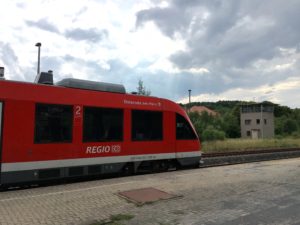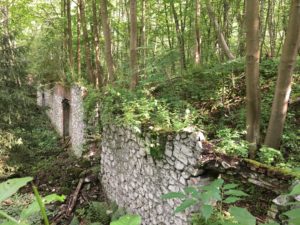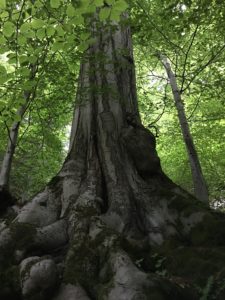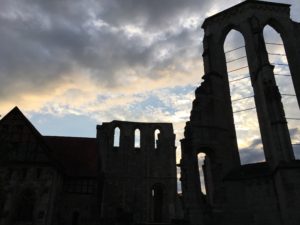Greetings from the the borderland! – with a few days’ delay because of intermittent internet access.
 I started the current leg of my expedition in the small town of Ellrich, in the southern foothills of the Harz Mountains – right in the center of Germany. Ellrich sits just east of the former border, which means that its residents were under special scrutiny during the time of the German division. People who lived within 5 kilometers (3 miles) of the border (the “Sperrgebiet or exclusion zone) needed to have their identity papers stamped and could not receive visitors other than family members from outside that zone – and permission for those visits needed to be applied for well ahead of time. Within a 500 meter (approx. 1,650 ft) zone (the “Schutzstreifen“) the restrictions were even harsher. Along the entire length of the former border, there were no signs pointing to towns like Ellrich, to prevent potential Republikflüchtlinge (“refugees from the republic”) from finding the border.
I started the current leg of my expedition in the small town of Ellrich, in the southern foothills of the Harz Mountains – right in the center of Germany. Ellrich sits just east of the former border, which means that its residents were under special scrutiny during the time of the German division. People who lived within 5 kilometers (3 miles) of the border (the “Sperrgebiet or exclusion zone) needed to have their identity papers stamped and could not receive visitors other than family members from outside that zone – and permission for those visits needed to be applied for well ahead of time. Within a 500 meter (approx. 1,650 ft) zone (the “Schutzstreifen“) the restrictions were even harsher. Along the entire length of the former border, there were no signs pointing to towns like Ellrich, to prevent potential Republikflüchtlinge (“refugees from the republic”) from finding the border.
 From the Ellrich train station (which had once been the site of an unsuccessful escape attempt by train), I crossed the tracks to pick up the “border trail” bike route to the nearby village of Walkenried, ten km away on the western side of the former border. There were no signs of the former border installations, and to my delight, the path led through a lush forest. Sun-dappled leaves in all shades of green; occasional bursts of bird song … The delight soon turned to dread as I realized that the forest had grown up over the remains of a subcamp of the Mittelbau-Dora concentration camp. For the next while, I kept coming
From the Ellrich train station (which had once been the site of an unsuccessful escape attempt by train), I crossed the tracks to pick up the “border trail” bike route to the nearby village of Walkenried, ten km away on the western side of the former border. There were no signs of the former border installations, and to my delight, the path led through a lush forest. Sun-dappled leaves in all shades of green; occasional bursts of bird song … The delight soon turned to dread as I realized that the forest had grown up over the remains of a subcamp of the Mittelbau-Dora concentration camp. For the next while, I kept coming  upon memorial markers and interpretive signs outlining the suffering of inmates (mostly forced laborers from Eastern Europe) at various sites within the subcamp.
upon memorial markers and interpretive signs outlining the suffering of inmates (mostly forced laborers from Eastern Europe) at various sites within the subcamp.
So my first 24 hours in the borderland catapulted me straight through to the “hell” portion of today’s title. I had known that the subcamp had been near Ellrich, and had wanted to seek out the memorial site… and still, mental preparation does not make the actual experience of such places any better. So I rode on with a heavy heart, glad about the physical challenge of the trail and the earthy smell of the forest.
After checking in to my modest quarters in Walkenried, I decided to explore a bit more in hopes of finding the “Himmelreich” (realm of heaven), a part of the forest I had read about. Soon enough, I found myself on a rather narrow trail with a steep drop on one side – hiking boots would have been better suited to this exploration than a bicycle, but the wind was picking up and the air had started to smell like rain, so I told myself I would turn around soon. And just then, I came across some of the  huge beech trees I had read about. I guessed that it would take three people to reach around the massive trunk. An interpretive sign nearby pointed out the mealy white substance visible at the base of the massive trunk and explained that this was “Himmelsmehl” (flour of heaven). It is said that in the Middle Ages,, people used this substance to bake bread during times of famine – with disastrous results, since it is actually gypsum and forms hard clumps once reconstituted.
huge beech trees I had read about. I guessed that it would take three people to reach around the massive trunk. An interpretive sign nearby pointed out the mealy white substance visible at the base of the massive trunk and explained that this was “Himmelsmehl” (flour of heaven). It is said that in the Middle Ages,, people used this substance to bake bread during times of famine – with disastrous results, since it is actually gypsum and forms hard clumps once reconstituted.
The gypsum is a special feature of the Harz region’s geology. A 5 km wide ribbon of it was deposited some 300-400 million years ago, when the region was covered by a shallow sea. Gypsum is a highly soluble rock, resulting in a so-called Karst landscape full of caves, sinkholes, and disappearing streams.
 I ended the evening’s exploration with a brief stop at Walkenried Abbey, a Cistercian monastery that goes back to the 12 th century. One would not guess from the skeletal remains of the monastery church that the presence of the monks has left profound legacies in the landscape. The most visible of these is a series of ponds (over 300!) they constructed to catch enough water for fish farming in the porous karst landscape. But they were active in agriculture and mining as well and shaped not only the landscape but the economy and social fabric of the region for centuries.
I ended the evening’s exploration with a brief stop at Walkenried Abbey, a Cistercian monastery that goes back to the 12 th century. One would not guess from the skeletal remains of the monastery church that the presence of the monks has left profound legacies in the landscape. The most visible of these is a series of ponds (over 300!) they constructed to catch enough water for fish farming in the porous karst landscape. But they were active in agriculture and mining as well and shaped not only the landscape but the economy and social fabric of the region for centuries.

Ugh. Hell is perhaps a more apt description than you thought. Dora was a work camp housing the “Mittelwerk,” the manufacturer created to build Wernher von Braun’s V-2 rockets. Before 1944, pretty much all of it was in the gypsum caverns under ground to protect it from Allied bombing. After this date, the factory was expanded to increase production and the prisoners were moved above ground at Dora and right next to the train station at Ellrich. So despite appearances, you traveled a path well worn with misery. I won’t relate here the horrible accounts I’ve read.
We bear equal shame for this in America, since we spirited the top tier of Nazi rocket scientists back here to work on our missile programs (including von Braun and his manager, Gen. Walter Dornberger) immediately after the war. The reality that no one knows is that it’s really those prisoners who put our Apollo astronauts on the moon.
So very interesting! What a deep phenomenally diververse day! The well of emotion and hist- STORY! Very interesting!
Greetings from New York City, Kerstin. Your posting of today was very thought-provoking. It is particularly nice how you combine both social and natural history. I look forward to reading – and learning – more from you. Great photographs too. Hugs, Gerard
Wheres mention of Rigby? HA!
You are very much missed. Hope you have a wonderful time. Very much enjoying your blog.
Your post reminds me of the layered experience of the world those of us have who care to look for it. The beauty of the beach tree … and the sadness of the concentration camp memorials. And the town that existed but had no signs to help people in need find their way there. Thank you for sharing your experience. Hugs and happy wanderings.
Es ist toll, die Region und ihre Geschichte durch deine Augen zu sehen, Kerstin. Ich freue mich sehr auf die Fortsetzungen.
Kerstin, your writing is fabulous!–Dennis
[…] I’m afraid, lasted quite a bit beyond his closing time – about life in the GDR and the Sperrgebiet, about how he came to be a bike shop owner, and about people who come into his shop to try out […]